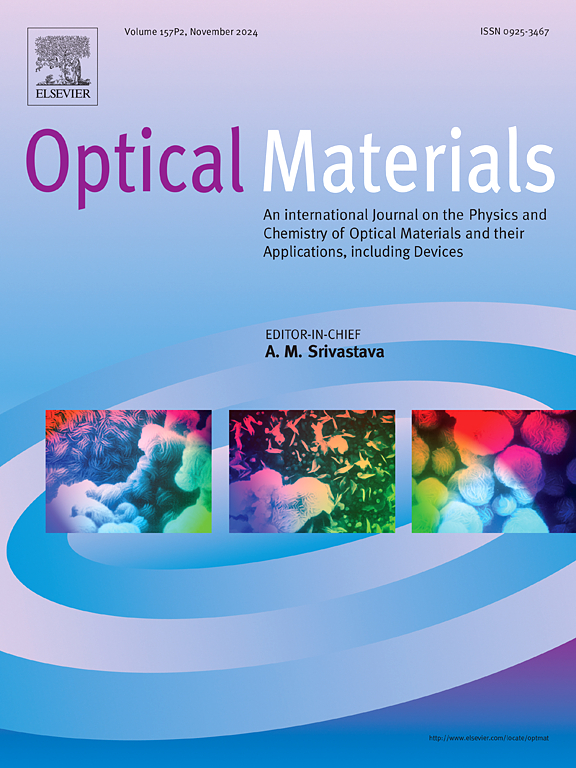Unravelling the influence of Ag{111} nanoprism on the redox characteristics of Fe2O3 for efficient photocatalytic degradation
IF 3.8
3区 材料科学
Q2 MATERIALS SCIENCE, MULTIDISCIPLINARY
引用次数: 0
Abstract
Incorporating noble metal nanostructures onto metal oxides surface can significantly improve the photocatalytic performance towards dye degradation. Hematite (α-Fe2O3) is considered as a potential candidate for photocatalytic applications due to its unique optoelectronic properties. However, improving the light absorption co-efficient and the excitonic carrier lifetime in Fe2O3 is highly required which can be achieved through the incorporation of noble metals. Hence, in this work, different silver (Ag) nanostructures such as Ag nanospheres and Ag {111} nanoprisms are incorporated on Fe2O3 surface, thereby enhancing the absorption co-efficient of Fe2O3 through localized surface plasmon resonance (LSPR) of Ag nanostructures. Initially, a solid-state sintering technique was employed to prepare pure Fe2O3, then Ag nanostructures has been incorporated by constant stirring of Fe2O3 and Ag nanostructures in aqueous solution. The structural, morphological and vibration properties were studied by XRD, FESEM, HRTEM, XPS, and Raman analysis respectively. UV–Visible spectral analysis revealed that the optical bandgap energy of Fe2O3 gets decreased from 1.93 eV to 1.81 eV upon Ag nanostructures incorporation. Further, time-resolved photoluminescence measurements demonstrated an improved carrier lifetime in Ag{111}/Fe2O3 (2.67 ns) compared to Ag nanospheres/Fe2O3 (2.5 ns) and pure Fe2O3 (1.05 ns). Photocatalytic performance of the prepared samples were evaluated by the degradation of aqueous Rhodamine-6G dye, and the results showed a significant improvement in degradation efficiency, with a maximum photocatalytic efficiency of 87.47 % and a rate constant of 0.0482 min−1. The result implies that the optoelectronic properties of Ag NSs plays a crucial role on the redox reactions involved in the photocatalytic dye degradation.
Ag{111}纳米棱镜对Fe2O3高效光催化降解氧化还原特性的影响
在金属氧化物表面加入贵金属纳米结构可以显著提高其光催化降解染料的性能。赤铁矿(α-Fe2O3)由于其独特的光电特性而被认为是光催化应用的潜在候选者。然而,提高Fe2O3中的光吸收系数和激子载流子寿命是非常必要的,这可以通过加入贵金属来实现。因此,在本研究中,不同的银(Ag)纳米结构(如Ag纳米球和Ag{111}纳米棱镜)被掺入Fe2O3表面,从而通过Ag纳米结构的局部表面等离子体共振(LSPR)提高Fe2O3的吸收效率。首先采用固态烧结技术制备纯Fe2O3,然后通过在水溶液中不断搅拌Fe2O3和Ag纳米结构来掺入Ag纳米结构。采用XRD、FESEM、HRTEM、XPS和Raman等分析手段研究了材料的结构、形貌和振动性能。紫外可见光谱分析表明,掺入Ag纳米结构后,Fe2O3的带隙能从1.93 eV降至1.81 eV。此外,时间分辨光致发光测量表明,与银纳米球/Fe2O3 (2.5 ns)和纯Fe2O3 (1.05 ns)相比,Ag{111}/Fe2O3的载流子寿命(2.67 ns)有所改善。通过对水溶液罗丹明- 6g染料的降解评价了所制备样品的光催化性能,结果表明,降解效率显著提高,最大光催化效率为87.47%,速率常数为0.0482 min−1。结果表明,Ag纳米粒子的光电性质对光催化染料降解过程中的氧化还原反应起着至关重要的作用。
本文章由计算机程序翻译,如有差异,请以英文原文为准。
求助全文
约1分钟内获得全文
求助全文
来源期刊

Optical Materials
工程技术-材料科学:综合
CiteScore
6.60
自引率
12.80%
发文量
1265
审稿时长
38 days
期刊介绍:
Optical Materials has an open access mirror journal Optical Materials: X, sharing the same aims and scope, editorial team, submission system and rigorous peer review.
The purpose of Optical Materials is to provide a means of communication and technology transfer between researchers who are interested in materials for potential device applications. The journal publishes original papers and review articles on the design, synthesis, characterisation and applications of optical materials.
OPTICAL MATERIALS focuses on:
• Optical Properties of Material Systems;
• The Materials Aspects of Optical Phenomena;
• The Materials Aspects of Devices and Applications.
Authors can submit separate research elements describing their data to Data in Brief and methods to Methods X.
 求助内容:
求助内容: 应助结果提醒方式:
应助结果提醒方式:


